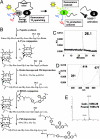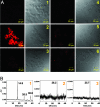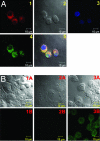Photodynamic molecular beacon as an activatable photosensitizer based on protease-controlled singlet oxygen quenching and activation
- PMID: 17502620
- PMCID: PMC1868591
- DOI: 10.1073/pnas.0611142104
Photodynamic molecular beacon as an activatable photosensitizer based on protease-controlled singlet oxygen quenching and activation
Abstract
Molecular beacons are FRET-based target-activatable probes. They offer control of fluorescence emission in response to specific cancer targets, thus are useful tools for in vivo cancer imaging. Photodynamic therapy (PDT) is a cell-killing process by light activation of a photosensitizer (PS) in the presence of oxygen. The key cytotoxic agent is singlet oxygen ((1)O(2)). By combining these two principles (FRET and PDT), we have introduced a concept of photodynamic molecular beacons (PMB) for controlling the PS's ability to generate (1)O(2) and, ultimately, for controlling its PDT activity. The PMB comprises a disease-specific linker, a PS, and a (1)O(2) quencher, so that the PS's photoactivity is silenced until the linker interacts with a target molecule, such as a tumor-associated protease. Here, we report the full implementation of this concept by synthesizing a matrix metalloproteinase-7 (MMP7)-triggered PMB and achieving not only MMP7-triggered production of (1)O(2) in solution but also MMP7-mediated photodynamic cytotoxicity in cancer cells. Preliminary in vivo studies also reveal the MMP7-activated PDT efficacy of this PMB. This study validates the core principle of the PMB concept that selective PDT-induced cell death can be achieved by exerting precise control of the PS's ability to produce (1)O(2) by responding to specific cancer-associated biomarkers. Thus, PDT selectivity will no longer depend solely on how selectively the PS can be delivered to cancer cells. Rather, it will depend on how selective a biomarker is to cancer cells, and how selective the interaction of PMB is to this biomarker.
Conflict of interest statement
The authors declare no conflict of interest.
Figures






References
-
- Pinthus JH, Bogaards A, Weersink R, Wilson BC, Trachtenberg J. J Urol. 2006;175:1201–1207. - PubMed
-
- Chen B, Pogue BW, Hasan T. Exp Opin Drug Del. 2005;2:477–487. - PubMed
-
- Sharman WM, van Lier JE, Allen CM. Adv Drug Del Rev. 2004;56:53–76. - PubMed
-
- Zhang M, Zhang Z, Blessington D, Li H, Busch TM, Madrak V, Miles J, Chance B, Glickson JD, Zheng G. Bioconjug Chem. 2003;14:709–714. - PubMed
Publication types
MeSH terms
Substances
Grants and funding
LinkOut - more resources
Full Text Sources
Other Literature Sources

